CX554101: Marketing Plan for Starbucks Bubble Tea in New Zealand
VerifiedAdded on 2023/03/17
|17
|5152
|28
Report
AI Summary
This report presents a comprehensive marketing plan for the launch of Starbucks' Bubble Tea in the New Zealand market. It begins with an executive summary outlining the market analysis, including internal and external environments, SWOT analysis, and target market segmentation focusing on youth, business people, and travelers. The report then details SMART objectives, competitive advantages, and marketing strategies encompassing product, pricing, place, and promotion decisions. It also discusses methods for controlling and integrating the marketing mix, along with the market size, trends, and competitor analysis, including Coca-Cola and Dunkin' Donuts. The plan emphasizes the importance of advertising, competitive pricing, and various deals to attract customers and increase market share. The report also considers the political, economic, social, and technological factors influencing the market and provides detailed demographic, geographic, psychographic, and behavioral segmentation approaches for the product's successful launch.
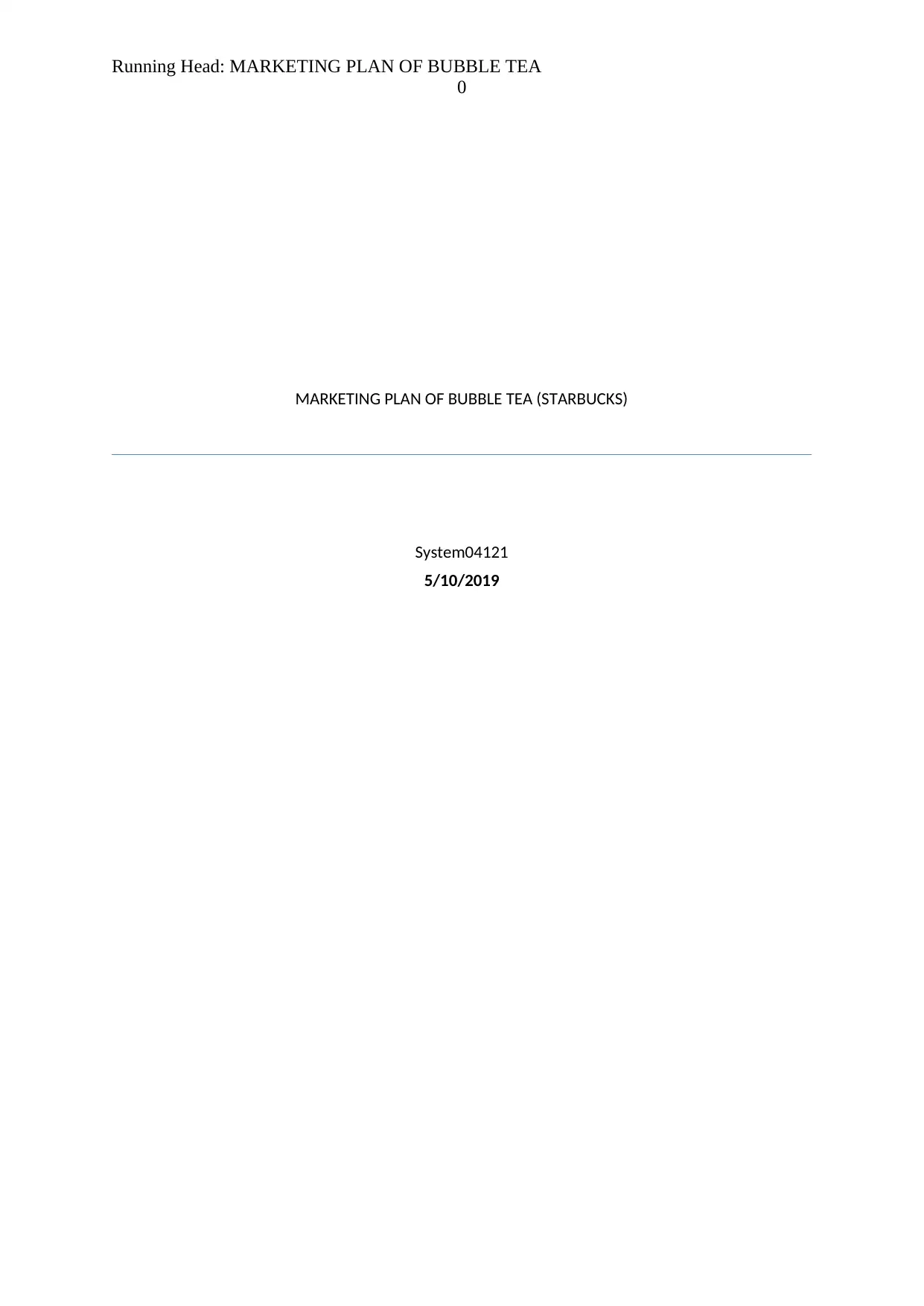
Running Head: MARKETING PLAN OF BUBBLE TEA
0
MARKETING PLAN OF BUBBLE TEA (STARBUCKS)
System04121
5/10/2019
0
MARKETING PLAN OF BUBBLE TEA (STARBUCKS)
System04121
5/10/2019
Paraphrase This Document
Need a fresh take? Get an instant paraphrase of this document with our AI Paraphraser
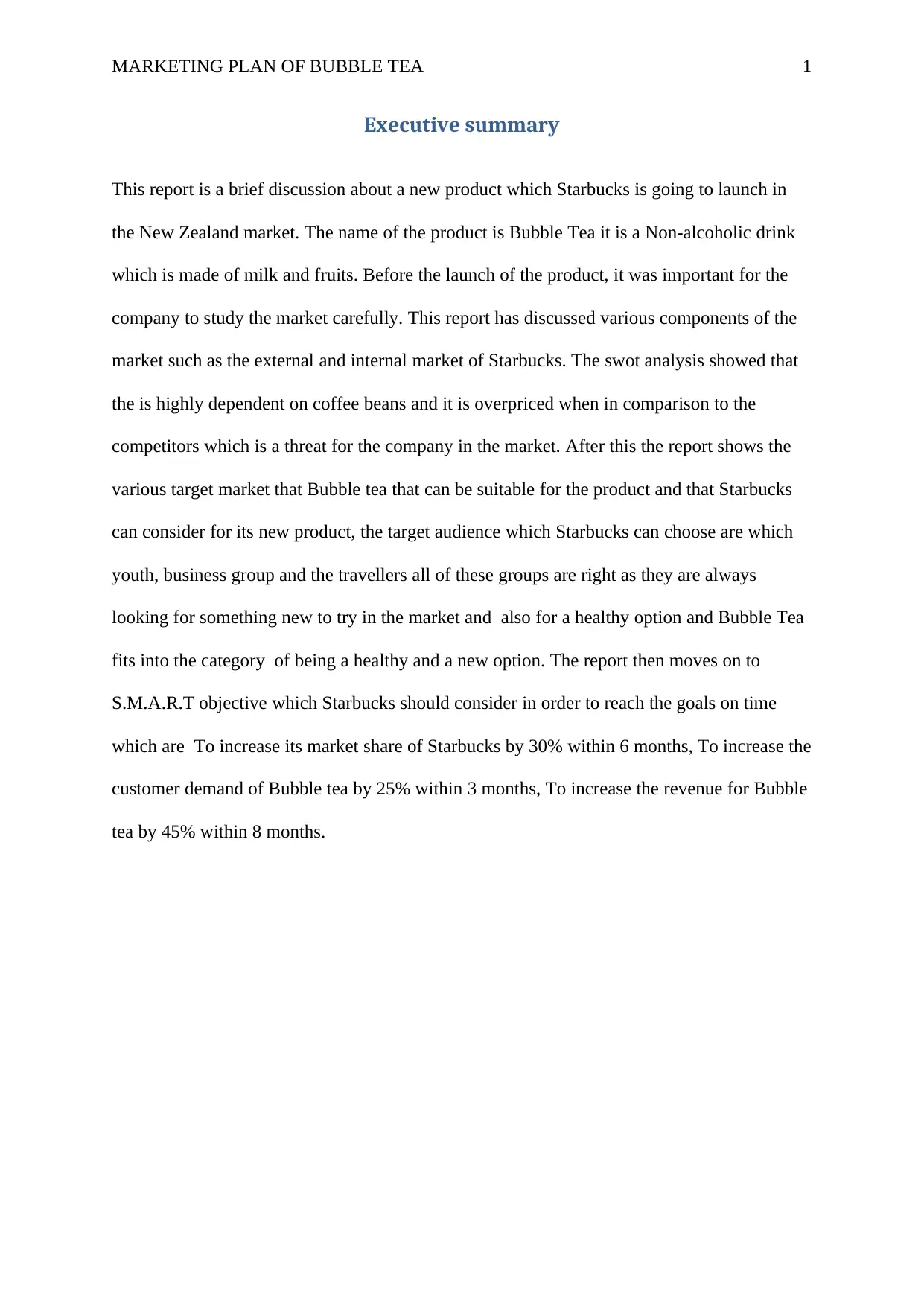
MARKETING PLAN OF BUBBLE TEA 1
Executive summary
This report is a brief discussion about a new product which Starbucks is going to launch in
the New Zealand market. The name of the product is Bubble Tea it is a Non-alcoholic drink
which is made of milk and fruits. Before the launch of the product, it was important for the
company to study the market carefully. This report has discussed various components of the
market such as the external and internal market of Starbucks. The swot analysis showed that
the is highly dependent on coffee beans and it is overpriced when in comparison to the
competitors which is a threat for the company in the market. After this the report shows the
various target market that Bubble tea that can be suitable for the product and that Starbucks
can consider for its new product, the target audience which Starbucks can choose are which
youth, business group and the travellers all of these groups are right as they are always
looking for something new to try in the market and also for a healthy option and Bubble Tea
fits into the category of being a healthy and a new option. The report then moves on to
S.M.A.R.T objective which Starbucks should consider in order to reach the goals on time
which are To increase its market share of Starbucks by 30% within 6 months, To increase the
customer demand of Bubble tea by 25% within 3 months, To increase the revenue for Bubble
tea by 45% within 8 months.
Executive summary
This report is a brief discussion about a new product which Starbucks is going to launch in
the New Zealand market. The name of the product is Bubble Tea it is a Non-alcoholic drink
which is made of milk and fruits. Before the launch of the product, it was important for the
company to study the market carefully. This report has discussed various components of the
market such as the external and internal market of Starbucks. The swot analysis showed that
the is highly dependent on coffee beans and it is overpriced when in comparison to the
competitors which is a threat for the company in the market. After this the report shows the
various target market that Bubble tea that can be suitable for the product and that Starbucks
can consider for its new product, the target audience which Starbucks can choose are which
youth, business group and the travellers all of these groups are right as they are always
looking for something new to try in the market and also for a healthy option and Bubble Tea
fits into the category of being a healthy and a new option. The report then moves on to
S.M.A.R.T objective which Starbucks should consider in order to reach the goals on time
which are To increase its market share of Starbucks by 30% within 6 months, To increase the
customer demand of Bubble tea by 25% within 3 months, To increase the revenue for Bubble
tea by 45% within 8 months.
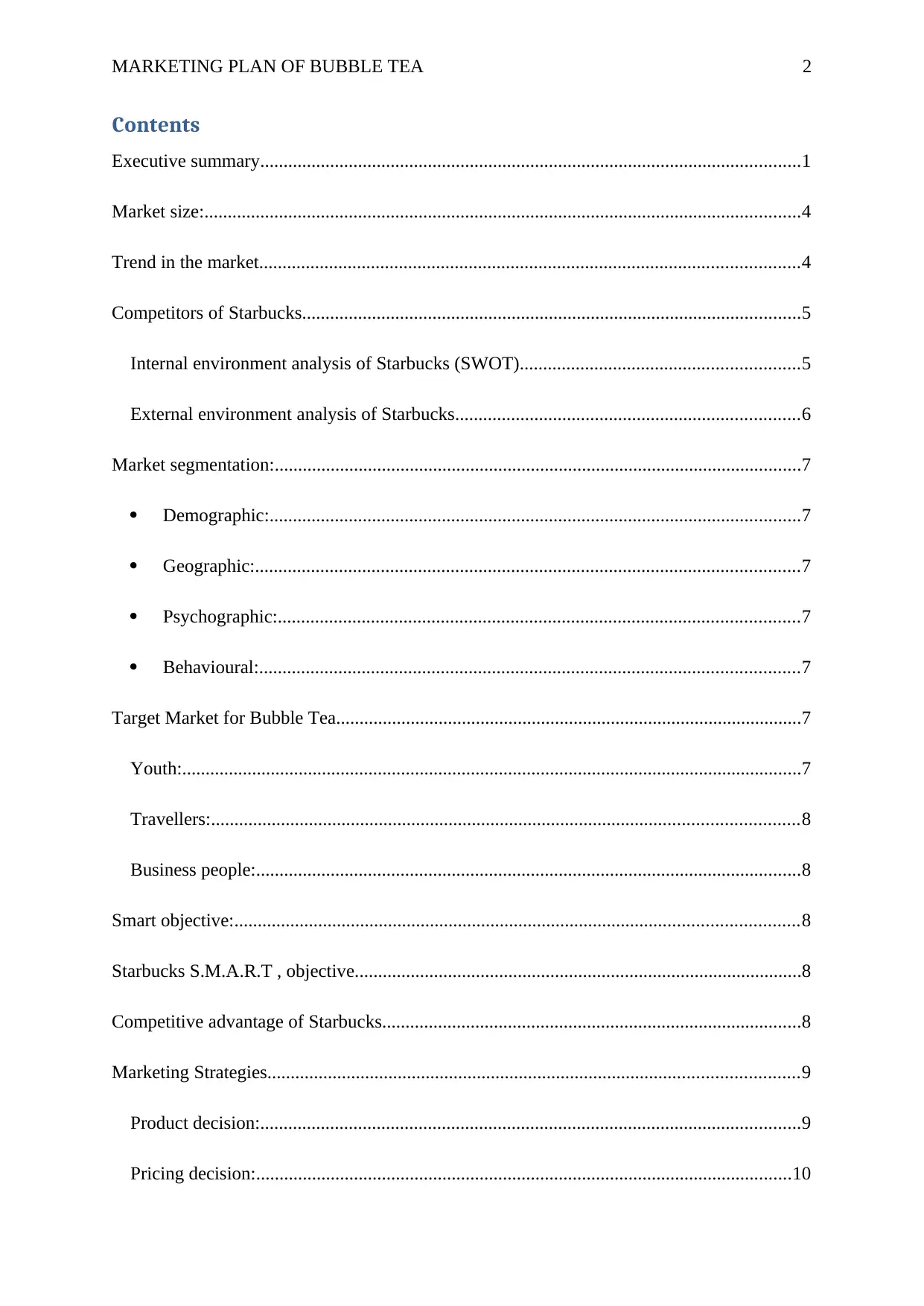
MARKETING PLAN OF BUBBLE TEA 2
Contents
Executive summary....................................................................................................................1
Market size:................................................................................................................................4
Trend in the market....................................................................................................................4
Competitors of Starbucks...........................................................................................................5
Internal environment analysis of Starbucks (SWOT)............................................................5
External environment analysis of Starbucks..........................................................................6
Market segmentation:.................................................................................................................7
Demographic:..................................................................................................................7
Geographic:.....................................................................................................................7
Psychographic:................................................................................................................7
Behavioural:....................................................................................................................7
Target Market for Bubble Tea....................................................................................................7
Youth:.....................................................................................................................................7
Travellers:..............................................................................................................................8
Business people:.....................................................................................................................8
Smart objective:.........................................................................................................................8
Starbucks S.M.A.R.T , objective................................................................................................8
Competitive advantage of Starbucks..........................................................................................8
Marketing Strategies..................................................................................................................9
Product decision:....................................................................................................................9
Pricing decision:...................................................................................................................10
Contents
Executive summary....................................................................................................................1
Market size:................................................................................................................................4
Trend in the market....................................................................................................................4
Competitors of Starbucks...........................................................................................................5
Internal environment analysis of Starbucks (SWOT)............................................................5
External environment analysis of Starbucks..........................................................................6
Market segmentation:.................................................................................................................7
Demographic:..................................................................................................................7
Geographic:.....................................................................................................................7
Psychographic:................................................................................................................7
Behavioural:....................................................................................................................7
Target Market for Bubble Tea....................................................................................................7
Youth:.....................................................................................................................................7
Travellers:..............................................................................................................................8
Business people:.....................................................................................................................8
Smart objective:.........................................................................................................................8
Starbucks S.M.A.R.T , objective................................................................................................8
Competitive advantage of Starbucks..........................................................................................8
Marketing Strategies..................................................................................................................9
Product decision:....................................................................................................................9
Pricing decision:...................................................................................................................10
⊘ This is a preview!⊘
Do you want full access?
Subscribe today to unlock all pages.

Trusted by 1+ million students worldwide
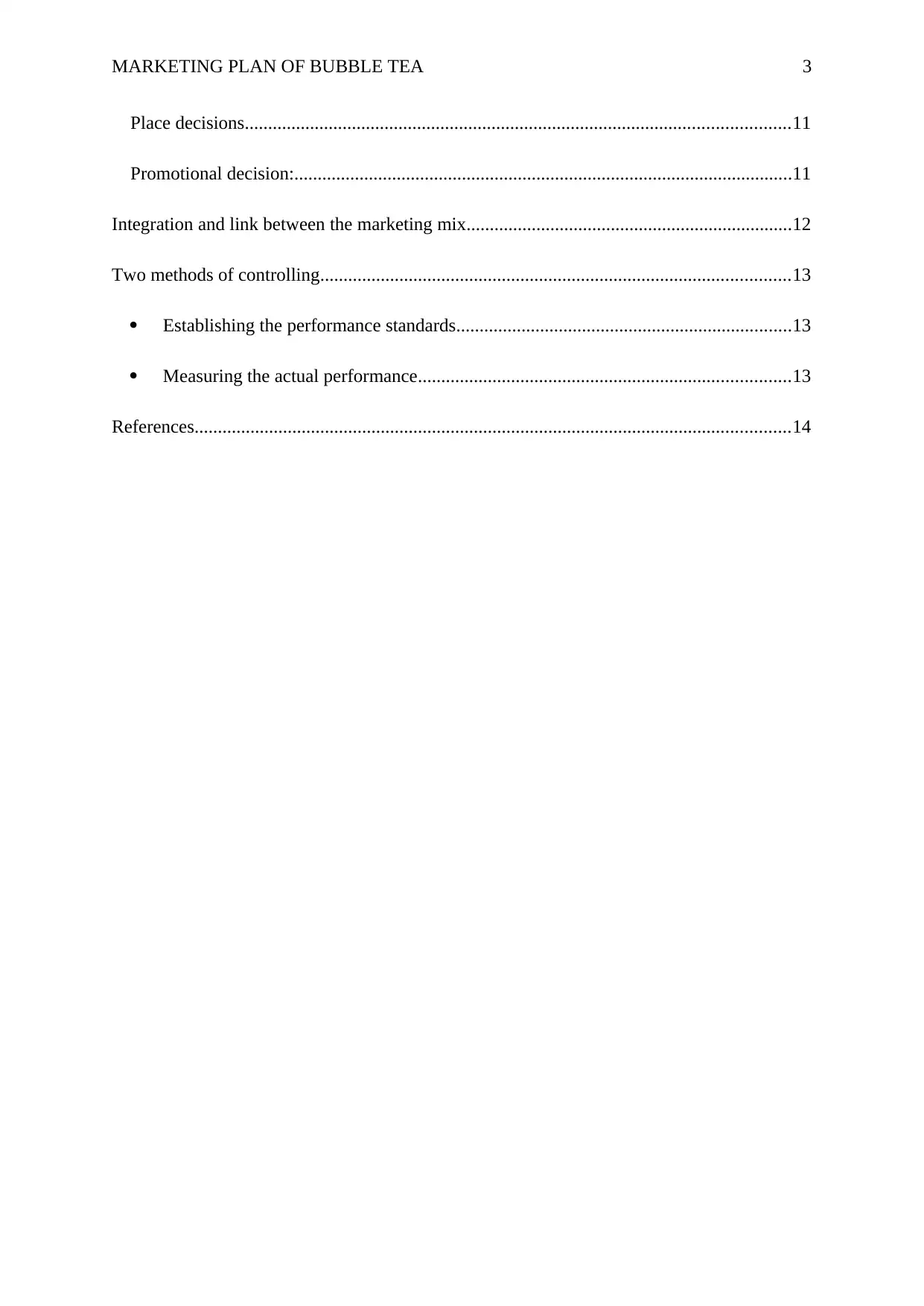
MARKETING PLAN OF BUBBLE TEA 3
Place decisions.....................................................................................................................11
Promotional decision:...........................................................................................................11
Integration and link between the marketing mix......................................................................12
Two methods of controlling.....................................................................................................13
Establishing the performance standards........................................................................13
Measuring the actual performance................................................................................13
References................................................................................................................................14
Place decisions.....................................................................................................................11
Promotional decision:...........................................................................................................11
Integration and link between the marketing mix......................................................................12
Two methods of controlling.....................................................................................................13
Establishing the performance standards........................................................................13
Measuring the actual performance................................................................................13
References................................................................................................................................14
Paraphrase This Document
Need a fresh take? Get an instant paraphrase of this document with our AI Paraphraser
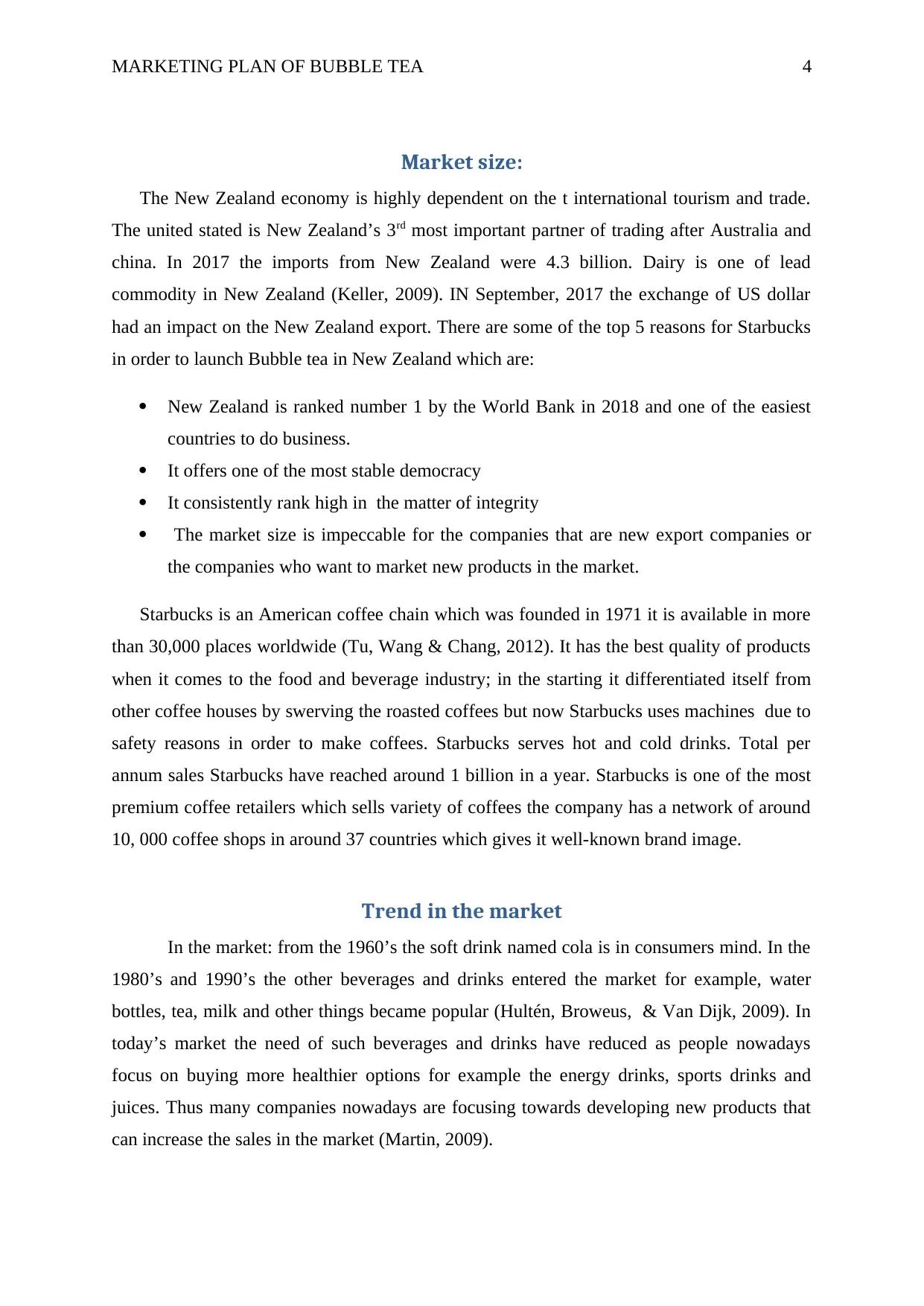
MARKETING PLAN OF BUBBLE TEA 4
Market size:
The New Zealand economy is highly dependent on the t international tourism and trade.
The united stated is New Zealand’s 3rd most important partner of trading after Australia and
china. In 2017 the imports from New Zealand were 4.3 billion. Dairy is one of lead
commodity in New Zealand (Keller, 2009). IN September, 2017 the exchange of US dollar
had an impact on the New Zealand export. There are some of the top 5 reasons for Starbucks
in order to launch Bubble tea in New Zealand which are:
New Zealand is ranked number 1 by the World Bank in 2018 and one of the easiest
countries to do business.
It offers one of the most stable democracy
It consistently rank high in the matter of integrity
The market size is impeccable for the companies that are new export companies or
the companies who want to market new products in the market.
Starbucks is an American coffee chain which was founded in 1971 it is available in more
than 30,000 places worldwide (Tu, Wang & Chang, 2012). It has the best quality of products
when it comes to the food and beverage industry; in the starting it differentiated itself from
other coffee houses by swerving the roasted coffees but now Starbucks uses machines due to
safety reasons in order to make coffees. Starbucks serves hot and cold drinks. Total per
annum sales Starbucks have reached around 1 billion in a year. Starbucks is one of the most
premium coffee retailers which sells variety of coffees the company has a network of around
10, 000 coffee shops in around 37 countries which gives it well-known brand image.
Trend in the market
In the market: from the 1960’s the soft drink named cola is in consumers mind. In the
1980’s and 1990’s the other beverages and drinks entered the market for example, water
bottles, tea, milk and other things became popular (Hultén, Broweus, & Van Dijk, 2009). In
today’s market the need of such beverages and drinks have reduced as people nowadays
focus on buying more healthier options for example the energy drinks, sports drinks and
juices. Thus many companies nowadays are focusing towards developing new products that
can increase the sales in the market (Martin, 2009).
Market size:
The New Zealand economy is highly dependent on the t international tourism and trade.
The united stated is New Zealand’s 3rd most important partner of trading after Australia and
china. In 2017 the imports from New Zealand were 4.3 billion. Dairy is one of lead
commodity in New Zealand (Keller, 2009). IN September, 2017 the exchange of US dollar
had an impact on the New Zealand export. There are some of the top 5 reasons for Starbucks
in order to launch Bubble tea in New Zealand which are:
New Zealand is ranked number 1 by the World Bank in 2018 and one of the easiest
countries to do business.
It offers one of the most stable democracy
It consistently rank high in the matter of integrity
The market size is impeccable for the companies that are new export companies or
the companies who want to market new products in the market.
Starbucks is an American coffee chain which was founded in 1971 it is available in more
than 30,000 places worldwide (Tu, Wang & Chang, 2012). It has the best quality of products
when it comes to the food and beverage industry; in the starting it differentiated itself from
other coffee houses by swerving the roasted coffees but now Starbucks uses machines due to
safety reasons in order to make coffees. Starbucks serves hot and cold drinks. Total per
annum sales Starbucks have reached around 1 billion in a year. Starbucks is one of the most
premium coffee retailers which sells variety of coffees the company has a network of around
10, 000 coffee shops in around 37 countries which gives it well-known brand image.
Trend in the market
In the market: from the 1960’s the soft drink named cola is in consumers mind. In the
1980’s and 1990’s the other beverages and drinks entered the market for example, water
bottles, tea, milk and other things became popular (Hultén, Broweus, & Van Dijk, 2009). In
today’s market the need of such beverages and drinks have reduced as people nowadays
focus on buying more healthier options for example the energy drinks, sports drinks and
juices. Thus many companies nowadays are focusing towards developing new products that
can increase the sales in the market (Martin, 2009).

MARKETING PLAN OF BUBBLE TEA 5
Competitors of Starbucks
Starbucks have a lot of competitors, for example Pepsi, coke; coca cola are one of the
top competitors in the industry of drinks. Coca cola is prominent with 43.7% from the total
market of soft drink industry. Starbucks have competitors primarily include dunking
doughnuts and McDonald’s. Starbucks have a slight advantage over the other 2 brands as the
other two brands does not have a coffee house atmosphere and with a drink like Bubble tea
which is very diverse from other drinks like of the Starbucks will be able to over perform in
front of it competitors.
Internal environment analysis of Starbucks (SWOT)
Strengths:
One of the main strengths of Starbucks is
that it has a very strong performance and it
has a number one spot in the industry of
beverages and retailers in the world.
the company is valued at around more
than 4 billion which one of the key
strength when it is compared to its
competitors (Helms, & Nixon, 2010).
The intangible strengths of Starbucks
include quality, rate and a position in the
market (Salinas, Li, & Li, 2013)
the company is also known for knowing
its employees too well and it take cares of
the workforce and keeps them happy all
the time
The company is one of the largest coffee
houses in the world because of the size
and the prize and product.
Weakness:
The company is highly reliant on on
the coffee beans and it also reliant on
the price of the beans for the
profitability. Starbucks is overpriced
when compared to competitors.
The company has come under fire in
the recent times for the obtaining
applies due to many public and
ecological activist (Yüksel,2012).
Opportunity:
To company has the opportunity expand
the supplier network and the supplier
range.
Starbucks has an opportunity to grow its
Threats:
The company faces issues from
raising the prices of the coffee beans
which is also related to the risk of
supply chain. The growth in price of
dairy products also impacts the
Competitors of Starbucks
Starbucks have a lot of competitors, for example Pepsi, coke; coca cola are one of the
top competitors in the industry of drinks. Coca cola is prominent with 43.7% from the total
market of soft drink industry. Starbucks have competitors primarily include dunking
doughnuts and McDonald’s. Starbucks have a slight advantage over the other 2 brands as the
other two brands does not have a coffee house atmosphere and with a drink like Bubble tea
which is very diverse from other drinks like of the Starbucks will be able to over perform in
front of it competitors.
Internal environment analysis of Starbucks (SWOT)
Strengths:
One of the main strengths of Starbucks is
that it has a very strong performance and it
has a number one spot in the industry of
beverages and retailers in the world.
the company is valued at around more
than 4 billion which one of the key
strength when it is compared to its
competitors (Helms, & Nixon, 2010).
The intangible strengths of Starbucks
include quality, rate and a position in the
market (Salinas, Li, & Li, 2013)
the company is also known for knowing
its employees too well and it take cares of
the workforce and keeps them happy all
the time
The company is one of the largest coffee
houses in the world because of the size
and the prize and product.
Weakness:
The company is highly reliant on on
the coffee beans and it also reliant on
the price of the beans for the
profitability. Starbucks is overpriced
when compared to competitors.
The company has come under fire in
the recent times for the obtaining
applies due to many public and
ecological activist (Yüksel,2012).
Opportunity:
To company has the opportunity expand
the supplier network and the supplier
range.
Starbucks has an opportunity to grow its
Threats:
The company faces issues from
raising the prices of the coffee beans
which is also related to the risk of
supply chain. The growth in price of
dairy products also impacts the
⊘ This is a preview!⊘
Do you want full access?
Subscribe today to unlock all pages.

Trusted by 1+ million students worldwide
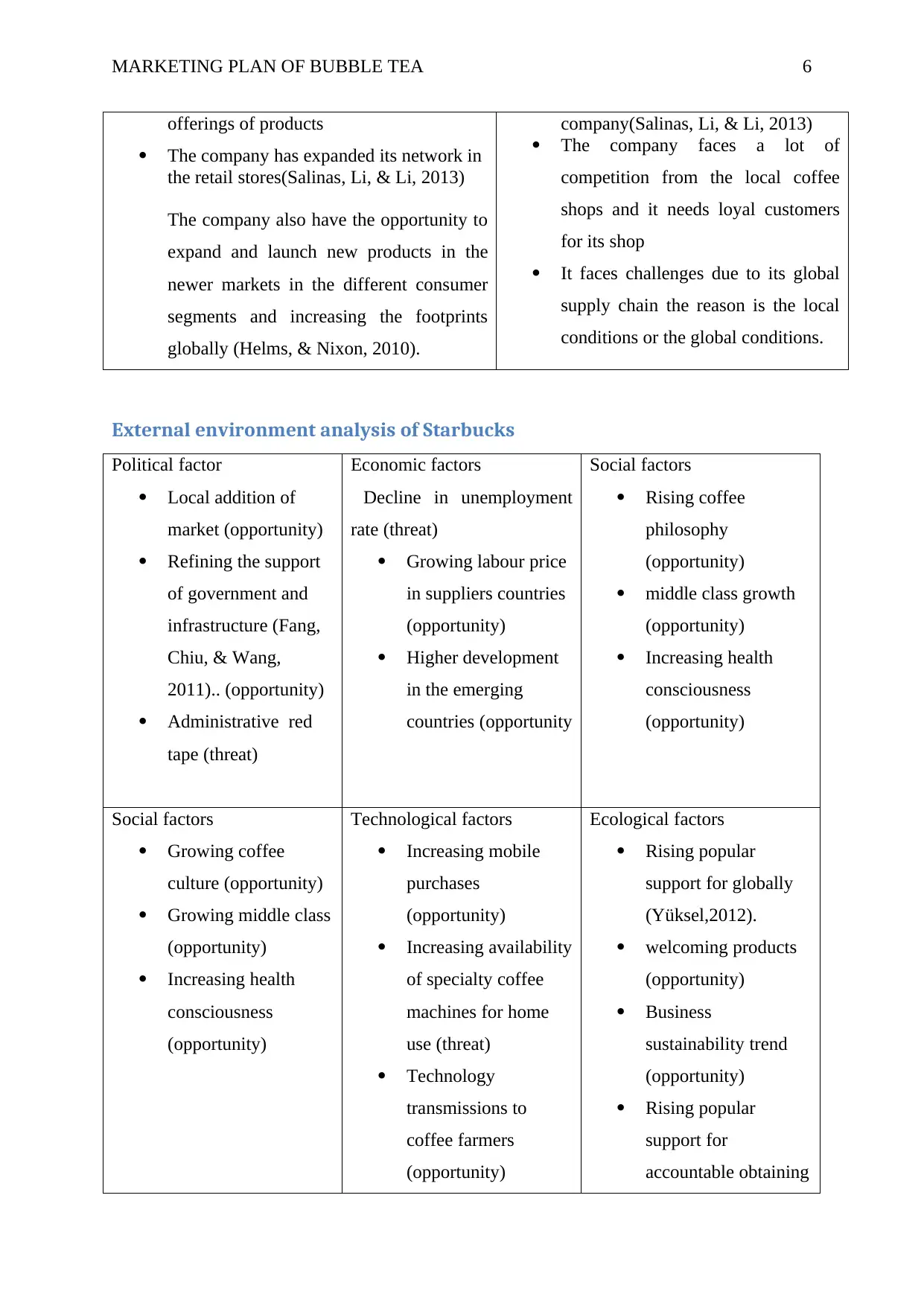
MARKETING PLAN OF BUBBLE TEA 6
offerings of products
The company has expanded its network in
the retail stores(Salinas, Li, & Li, 2013)
The company also have the opportunity to
expand and launch new products in the
newer markets in the different consumer
segments and increasing the footprints
globally (Helms, & Nixon, 2010).
company(Salinas, Li, & Li, 2013)
The company faces a lot of
competition from the local coffee
shops and it needs loyal customers
for its shop
It faces challenges due to its global
supply chain the reason is the local
conditions or the global conditions.
External environment analysis of Starbucks
Political factor
Local addition of
market (opportunity)
Refining the support
of government and
infrastructure (Fang,
Chiu, & Wang,
2011).. (opportunity)
Administrative red
tape (threat)
Economic factors
Decline in unemployment
rate (threat)
Growing labour price
in suppliers countries
(opportunity)
Higher development
in the emerging
countries (opportunity
Social factors
Rising coffee
philosophy
(opportunity)
middle class growth
(opportunity)
Increasing health
consciousness
(opportunity)
Social factors
Growing coffee
culture (opportunity)
Growing middle class
(opportunity)
Increasing health
consciousness
(opportunity)
Technological factors
Increasing mobile
purchases
(opportunity)
Increasing availability
of specialty coffee
machines for home
use (threat)
Technology
transmissions to
coffee farmers
(opportunity)
Ecological factors
Rising popular
support for globally
(Yüksel,2012).
welcoming products
(opportunity)
Business
sustainability trend
(opportunity)
Rising popular
support for
accountable obtaining
offerings of products
The company has expanded its network in
the retail stores(Salinas, Li, & Li, 2013)
The company also have the opportunity to
expand and launch new products in the
newer markets in the different consumer
segments and increasing the footprints
globally (Helms, & Nixon, 2010).
company(Salinas, Li, & Li, 2013)
The company faces a lot of
competition from the local coffee
shops and it needs loyal customers
for its shop
It faces challenges due to its global
supply chain the reason is the local
conditions or the global conditions.
External environment analysis of Starbucks
Political factor
Local addition of
market (opportunity)
Refining the support
of government and
infrastructure (Fang,
Chiu, & Wang,
2011).. (opportunity)
Administrative red
tape (threat)
Economic factors
Decline in unemployment
rate (threat)
Growing labour price
in suppliers countries
(opportunity)
Higher development
in the emerging
countries (opportunity
Social factors
Rising coffee
philosophy
(opportunity)
middle class growth
(opportunity)
Increasing health
consciousness
(opportunity)
Social factors
Growing coffee
culture (opportunity)
Growing middle class
(opportunity)
Increasing health
consciousness
(opportunity)
Technological factors
Increasing mobile
purchases
(opportunity)
Increasing availability
of specialty coffee
machines for home
use (threat)
Technology
transmissions to
coffee farmers
(opportunity)
Ecological factors
Rising popular
support for globally
(Yüksel,2012).
welcoming products
(opportunity)
Business
sustainability trend
(opportunity)
Rising popular
support for
accountable obtaining
Paraphrase This Document
Need a fresh take? Get an instant paraphrase of this document with our AI Paraphraser

MARKETING PLAN OF BUBBLE TEA 7
(opportunity)
Market segmentation:
Demographic: Starbucks will choose its demographic market segmentation for
Bubble Tea by targeting the customers between the ages of 18 to 25; these are the
kind of age group that are continuously looking for something new in the market. By
target this age group it will be able to get high results
Geographic: Geographic segmentation would be done in the following cities as
people are more into buying drinks in these countries and places Auckland,
Wellington, Hamilton and Tauranga
Psychographic: Geographic segmentation would be based on the people who are
rich or from the upper middle class families, these group segmentations are perfect
for Starbucks as Starbucks is a brand that has high priced products and only the
people and only these group of people can buy the products from Starbucks and thus
Starbucks can target these customers for the Bubble tea product it is going to launch
in the market
Behavioural: this segmentation will be studied by studying the various factors
such as the brand loyalty, benefits needed, usage frequency and the occasion of the
customers. on which basis does the customers buy products
Target Market for Bubble Tea
Youth: These are the people who would be among the ages of 18-24; this is the easiest
market to target as this age group is always easy to target as these age group are always
looking for new drinks and new things to try.
Travellers: These are the perfect audience for Starbucks in order to market this drink, as
the people who travel like to try out new things and, this drink can be a perfect option for this
type of audience.
Business people: These people mostly visit Starbucks for business meetings and all;
these are the people that Starbucks can target for their new drink Bubble tea. These people
(opportunity)
Market segmentation:
Demographic: Starbucks will choose its demographic market segmentation for
Bubble Tea by targeting the customers between the ages of 18 to 25; these are the
kind of age group that are continuously looking for something new in the market. By
target this age group it will be able to get high results
Geographic: Geographic segmentation would be done in the following cities as
people are more into buying drinks in these countries and places Auckland,
Wellington, Hamilton and Tauranga
Psychographic: Geographic segmentation would be based on the people who are
rich or from the upper middle class families, these group segmentations are perfect
for Starbucks as Starbucks is a brand that has high priced products and only the
people and only these group of people can buy the products from Starbucks and thus
Starbucks can target these customers for the Bubble tea product it is going to launch
in the market
Behavioural: this segmentation will be studied by studying the various factors
such as the brand loyalty, benefits needed, usage frequency and the occasion of the
customers. on which basis does the customers buy products
Target Market for Bubble Tea
Youth: These are the people who would be among the ages of 18-24; this is the easiest
market to target as this age group is always easy to target as these age group are always
looking for new drinks and new things to try.
Travellers: These are the perfect audience for Starbucks in order to market this drink, as
the people who travel like to try out new things and, this drink can be a perfect option for this
type of audience.
Business people: These people mostly visit Starbucks for business meetings and all;
these are the people that Starbucks can target for their new drink Bubble tea. These people
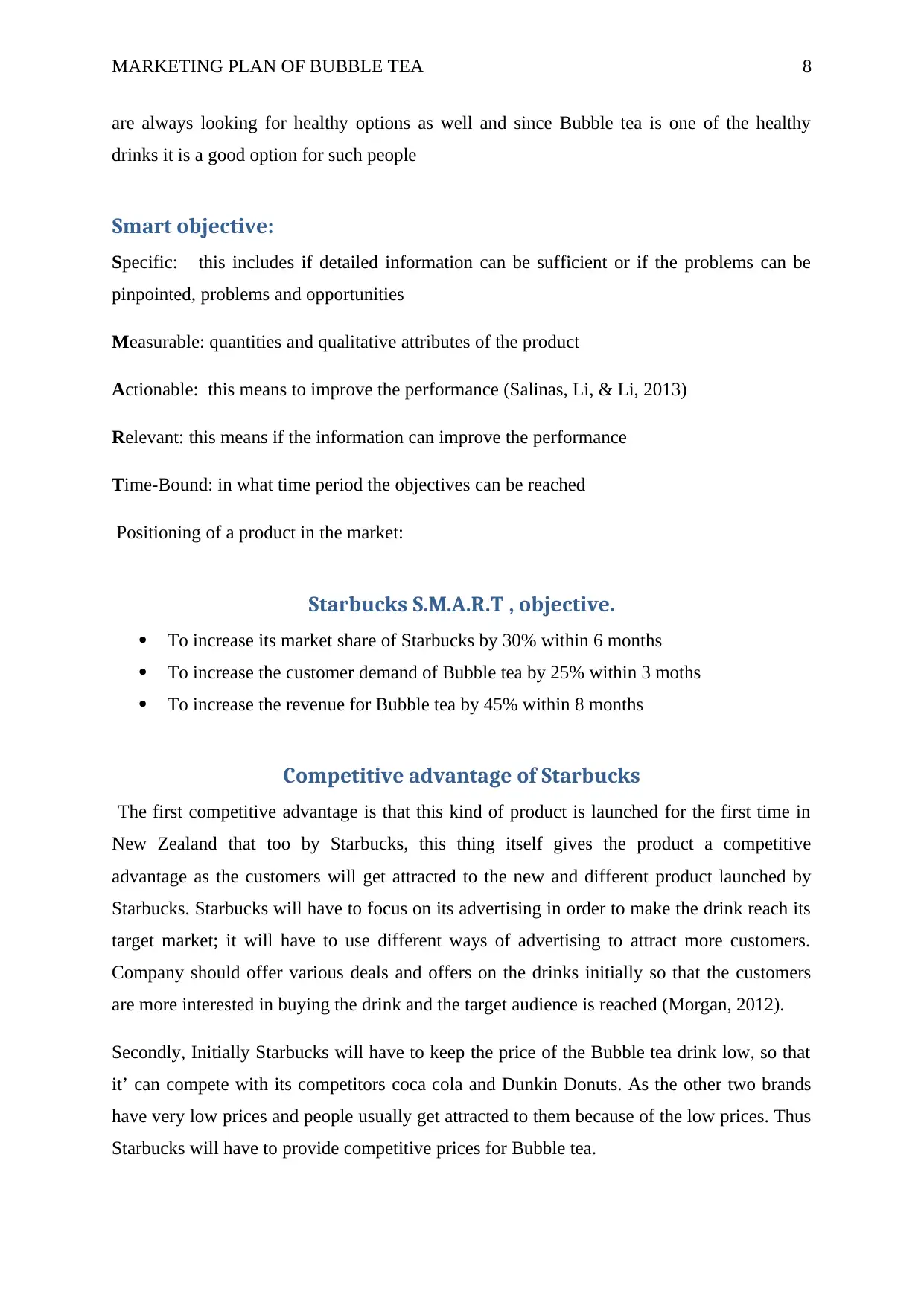
MARKETING PLAN OF BUBBLE TEA 8
are always looking for healthy options as well and since Bubble tea is one of the healthy
drinks it is a good option for such people
Smart objective:
Specific: this includes if detailed information can be sufficient or if the problems can be
pinpointed, problems and opportunities
Measurable: quantities and qualitative attributes of the product
Actionable: this means to improve the performance (Salinas, Li, & Li, 2013)
Relevant: this means if the information can improve the performance
Time-Bound: in what time period the objectives can be reached
Positioning of a product in the market:
Starbucks S.M.A.R.T , objective.
To increase its market share of Starbucks by 30% within 6 months
To increase the customer demand of Bubble tea by 25% within 3 moths
To increase the revenue for Bubble tea by 45% within 8 months
Competitive advantage of Starbucks
The first competitive advantage is that this kind of product is launched for the first time in
New Zealand that too by Starbucks, this thing itself gives the product a competitive
advantage as the customers will get attracted to the new and different product launched by
Starbucks. Starbucks will have to focus on its advertising in order to make the drink reach its
target market; it will have to use different ways of advertising to attract more customers.
Company should offer various deals and offers on the drinks initially so that the customers
are more interested in buying the drink and the target audience is reached (Morgan, 2012).
Secondly, Initially Starbucks will have to keep the price of the Bubble tea drink low, so that
it’ can compete with its competitors coca cola and Dunkin Donuts. As the other two brands
have very low prices and people usually get attracted to them because of the low prices. Thus
Starbucks will have to provide competitive prices for Bubble tea.
are always looking for healthy options as well and since Bubble tea is one of the healthy
drinks it is a good option for such people
Smart objective:
Specific: this includes if detailed information can be sufficient or if the problems can be
pinpointed, problems and opportunities
Measurable: quantities and qualitative attributes of the product
Actionable: this means to improve the performance (Salinas, Li, & Li, 2013)
Relevant: this means if the information can improve the performance
Time-Bound: in what time period the objectives can be reached
Positioning of a product in the market:
Starbucks S.M.A.R.T , objective.
To increase its market share of Starbucks by 30% within 6 months
To increase the customer demand of Bubble tea by 25% within 3 moths
To increase the revenue for Bubble tea by 45% within 8 months
Competitive advantage of Starbucks
The first competitive advantage is that this kind of product is launched for the first time in
New Zealand that too by Starbucks, this thing itself gives the product a competitive
advantage as the customers will get attracted to the new and different product launched by
Starbucks. Starbucks will have to focus on its advertising in order to make the drink reach its
target market; it will have to use different ways of advertising to attract more customers.
Company should offer various deals and offers on the drinks initially so that the customers
are more interested in buying the drink and the target audience is reached (Morgan, 2012).
Secondly, Initially Starbucks will have to keep the price of the Bubble tea drink low, so that
it’ can compete with its competitors coca cola and Dunkin Donuts. As the other two brands
have very low prices and people usually get attracted to them because of the low prices. Thus
Starbucks will have to provide competitive prices for Bubble tea.
⊘ This is a preview!⊘
Do you want full access?
Subscribe today to unlock all pages.

Trusted by 1+ million students worldwide
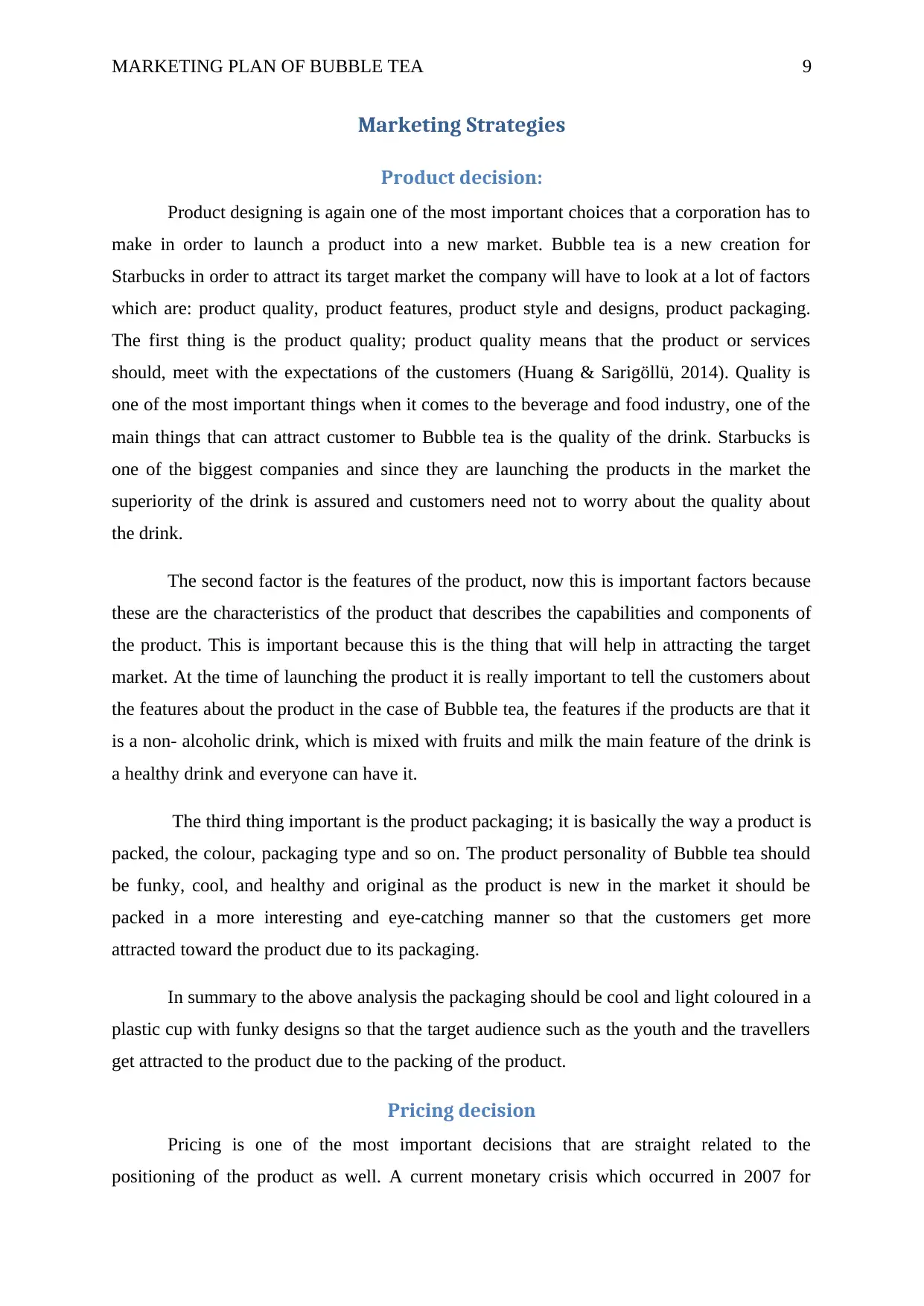
MARKETING PLAN OF BUBBLE TEA 9
Marketing Strategies
Product decision:
Product designing is again one of the most important choices that a corporation has to
make in order to launch a product into a new market. Bubble tea is a new creation for
Starbucks in order to attract its target market the company will have to look at a lot of factors
which are: product quality, product features, product style and designs, product packaging.
The first thing is the product quality; product quality means that the product or services
should, meet with the expectations of the customers (Huang & Sarigöllü, 2014). Quality is
one of the most important things when it comes to the beverage and food industry, one of the
main things that can attract customer to Bubble tea is the quality of the drink. Starbucks is
one of the biggest companies and since they are launching the products in the market the
superiority of the drink is assured and customers need not to worry about the quality about
the drink.
The second factor is the features of the product, now this is important factors because
these are the characteristics of the product that describes the capabilities and components of
the product. This is important because this is the thing that will help in attracting the target
market. At the time of launching the product it is really important to tell the customers about
the features about the product in the case of Bubble tea, the features if the products are that it
is a non- alcoholic drink, which is mixed with fruits and milk the main feature of the drink is
a healthy drink and everyone can have it.
The third thing important is the product packaging; it is basically the way a product is
packed, the colour, packaging type and so on. The product personality of Bubble tea should
be funky, cool, and healthy and original as the product is new in the market it should be
packed in a more interesting and eye-catching manner so that the customers get more
attracted toward the product due to its packaging.
In summary to the above analysis the packaging should be cool and light coloured in a
plastic cup with funky designs so that the target audience such as the youth and the travellers
get attracted to the product due to the packing of the product.
Pricing decision
Pricing is one of the most important decisions that are straight related to the
positioning of the product as well. A current monetary crisis which occurred in 2007 for
Marketing Strategies
Product decision:
Product designing is again one of the most important choices that a corporation has to
make in order to launch a product into a new market. Bubble tea is a new creation for
Starbucks in order to attract its target market the company will have to look at a lot of factors
which are: product quality, product features, product style and designs, product packaging.
The first thing is the product quality; product quality means that the product or services
should, meet with the expectations of the customers (Huang & Sarigöllü, 2014). Quality is
one of the most important things when it comes to the beverage and food industry, one of the
main things that can attract customer to Bubble tea is the quality of the drink. Starbucks is
one of the biggest companies and since they are launching the products in the market the
superiority of the drink is assured and customers need not to worry about the quality about
the drink.
The second factor is the features of the product, now this is important factors because
these are the characteristics of the product that describes the capabilities and components of
the product. This is important because this is the thing that will help in attracting the target
market. At the time of launching the product it is really important to tell the customers about
the features about the product in the case of Bubble tea, the features if the products are that it
is a non- alcoholic drink, which is mixed with fruits and milk the main feature of the drink is
a healthy drink and everyone can have it.
The third thing important is the product packaging; it is basically the way a product is
packed, the colour, packaging type and so on. The product personality of Bubble tea should
be funky, cool, and healthy and original as the product is new in the market it should be
packed in a more interesting and eye-catching manner so that the customers get more
attracted toward the product due to its packaging.
In summary to the above analysis the packaging should be cool and light coloured in a
plastic cup with funky designs so that the target audience such as the youth and the travellers
get attracted to the product due to the packing of the product.
Pricing decision
Pricing is one of the most important decisions that are straight related to the
positioning of the product as well. A current monetary crisis which occurred in 2007 for
Paraphrase This Document
Need a fresh take? Get an instant paraphrase of this document with our AI Paraphraser
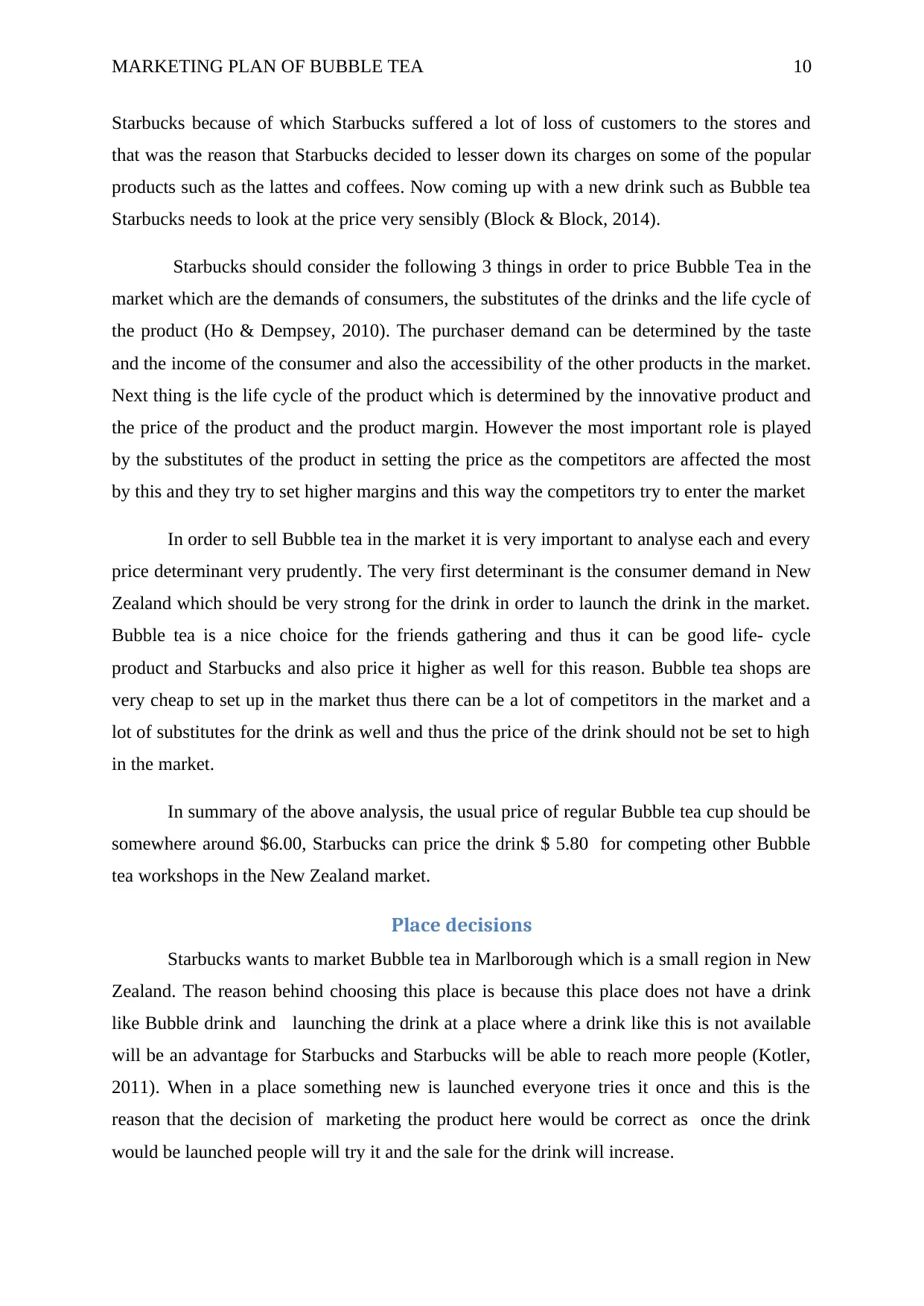
MARKETING PLAN OF BUBBLE TEA 10
Starbucks because of which Starbucks suffered a lot of loss of customers to the stores and
that was the reason that Starbucks decided to lesser down its charges on some of the popular
products such as the lattes and coffees. Now coming up with a new drink such as Bubble tea
Starbucks needs to look at the price very sensibly (Block & Block, 2014).
Starbucks should consider the following 3 things in order to price Bubble Tea in the
market which are the demands of consumers, the substitutes of the drinks and the life cycle of
the product (Ho & Dempsey, 2010). The purchaser demand can be determined by the taste
and the income of the consumer and also the accessibility of the other products in the market.
Next thing is the life cycle of the product which is determined by the innovative product and
the price of the product and the product margin. However the most important role is played
by the substitutes of the product in setting the price as the competitors are affected the most
by this and they try to set higher margins and this way the competitors try to enter the market
In order to sell Bubble tea in the market it is very important to analyse each and every
price determinant very prudently. The very first determinant is the consumer demand in New
Zealand which should be very strong for the drink in order to launch the drink in the market.
Bubble tea is a nice choice for the friends gathering and thus it can be good life- cycle
product and Starbucks and also price it higher as well for this reason. Bubble tea shops are
very cheap to set up in the market thus there can be a lot of competitors in the market and a
lot of substitutes for the drink as well and thus the price of the drink should not be set to high
in the market.
In summary of the above analysis, the usual price of regular Bubble tea cup should be
somewhere around $6.00, Starbucks can price the drink $ 5.80 for competing other Bubble
tea workshops in the New Zealand market.
Place decisions
Starbucks wants to market Bubble tea in Marlborough which is a small region in New
Zealand. The reason behind choosing this place is because this place does not have a drink
like Bubble drink and launching the drink at a place where a drink like this is not available
will be an advantage for Starbucks and Starbucks will be able to reach more people (Kotler,
2011). When in a place something new is launched everyone tries it once and this is the
reason that the decision of marketing the product here would be correct as once the drink
would be launched people will try it and the sale for the drink will increase.
Starbucks because of which Starbucks suffered a lot of loss of customers to the stores and
that was the reason that Starbucks decided to lesser down its charges on some of the popular
products such as the lattes and coffees. Now coming up with a new drink such as Bubble tea
Starbucks needs to look at the price very sensibly (Block & Block, 2014).
Starbucks should consider the following 3 things in order to price Bubble Tea in the
market which are the demands of consumers, the substitutes of the drinks and the life cycle of
the product (Ho & Dempsey, 2010). The purchaser demand can be determined by the taste
and the income of the consumer and also the accessibility of the other products in the market.
Next thing is the life cycle of the product which is determined by the innovative product and
the price of the product and the product margin. However the most important role is played
by the substitutes of the product in setting the price as the competitors are affected the most
by this and they try to set higher margins and this way the competitors try to enter the market
In order to sell Bubble tea in the market it is very important to analyse each and every
price determinant very prudently. The very first determinant is the consumer demand in New
Zealand which should be very strong for the drink in order to launch the drink in the market.
Bubble tea is a nice choice for the friends gathering and thus it can be good life- cycle
product and Starbucks and also price it higher as well for this reason. Bubble tea shops are
very cheap to set up in the market thus there can be a lot of competitors in the market and a
lot of substitutes for the drink as well and thus the price of the drink should not be set to high
in the market.
In summary of the above analysis, the usual price of regular Bubble tea cup should be
somewhere around $6.00, Starbucks can price the drink $ 5.80 for competing other Bubble
tea workshops in the New Zealand market.
Place decisions
Starbucks wants to market Bubble tea in Marlborough which is a small region in New
Zealand. The reason behind choosing this place is because this place does not have a drink
like Bubble drink and launching the drink at a place where a drink like this is not available
will be an advantage for Starbucks and Starbucks will be able to reach more people (Kotler,
2011). When in a place something new is launched everyone tries it once and this is the
reason that the decision of marketing the product here would be correct as once the drink
would be launched people will try it and the sale for the drink will increase.
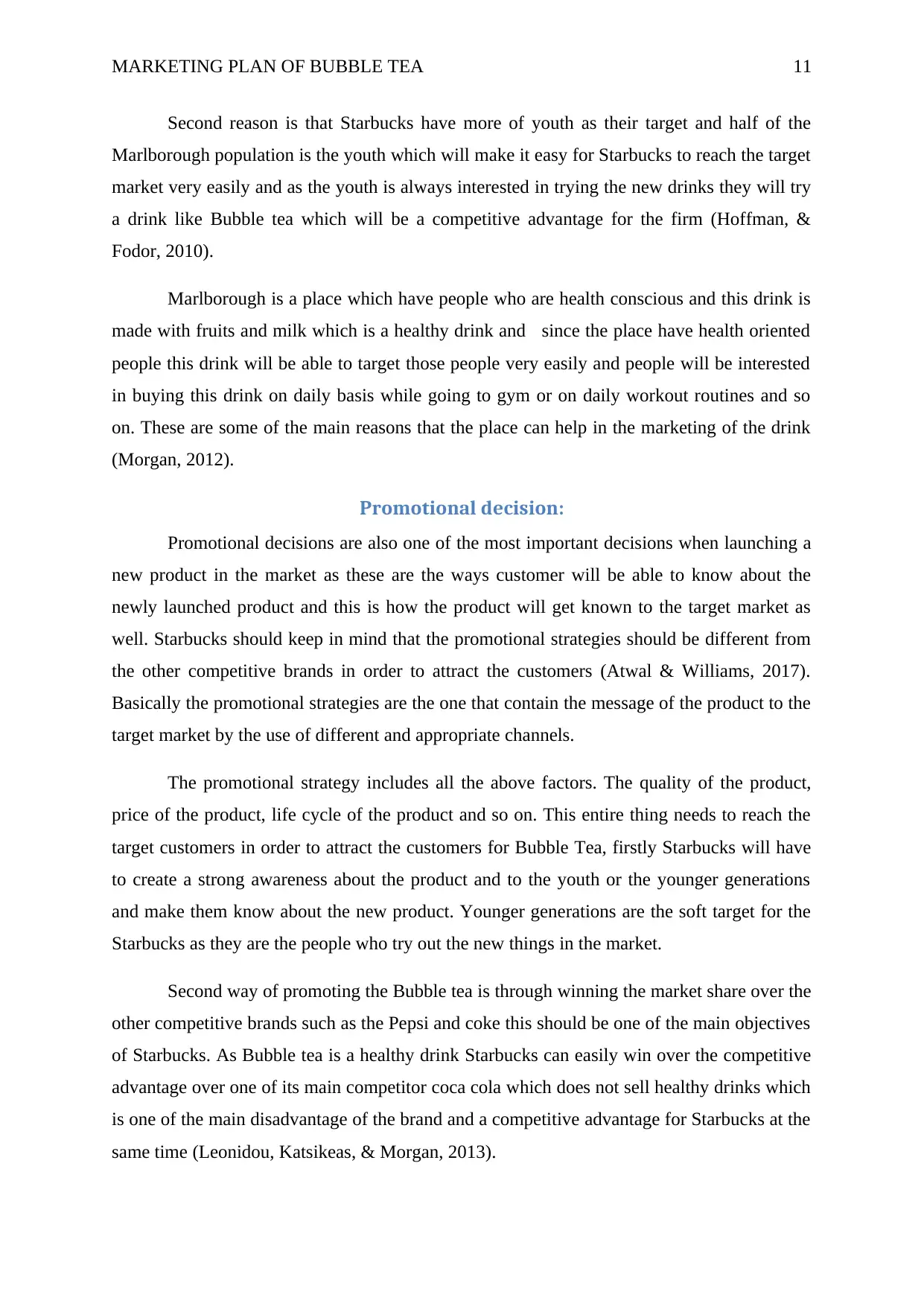
MARKETING PLAN OF BUBBLE TEA 11
Second reason is that Starbucks have more of youth as their target and half of the
Marlborough population is the youth which will make it easy for Starbucks to reach the target
market very easily and as the youth is always interested in trying the new drinks they will try
a drink like Bubble tea which will be a competitive advantage for the firm (Hoffman, &
Fodor, 2010).
Marlborough is a place which have people who are health conscious and this drink is
made with fruits and milk which is a healthy drink and since the place have health oriented
people this drink will be able to target those people very easily and people will be interested
in buying this drink on daily basis while going to gym or on daily workout routines and so
on. These are some of the main reasons that the place can help in the marketing of the drink
(Morgan, 2012).
Promotional decision:
Promotional decisions are also one of the most important decisions when launching a
new product in the market as these are the ways customer will be able to know about the
newly launched product and this is how the product will get known to the target market as
well. Starbucks should keep in mind that the promotional strategies should be different from
the other competitive brands in order to attract the customers (Atwal & Williams, 2017).
Basically the promotional strategies are the one that contain the message of the product to the
target market by the use of different and appropriate channels.
The promotional strategy includes all the above factors. The quality of the product,
price of the product, life cycle of the product and so on. This entire thing needs to reach the
target customers in order to attract the customers for Bubble Tea, firstly Starbucks will have
to create a strong awareness about the product and to the youth or the younger generations
and make them know about the new product. Younger generations are the soft target for the
Starbucks as they are the people who try out the new things in the market.
Second way of promoting the Bubble tea is through winning the market share over the
other competitive brands such as the Pepsi and coke this should be one of the main objectives
of Starbucks. As Bubble tea is a healthy drink Starbucks can easily win over the competitive
advantage over one of its main competitor coca cola which does not sell healthy drinks which
is one of the main disadvantage of the brand and a competitive advantage for Starbucks at the
same time (Leonidou, Katsikeas, & Morgan, 2013).
Second reason is that Starbucks have more of youth as their target and half of the
Marlborough population is the youth which will make it easy for Starbucks to reach the target
market very easily and as the youth is always interested in trying the new drinks they will try
a drink like Bubble tea which will be a competitive advantage for the firm (Hoffman, &
Fodor, 2010).
Marlborough is a place which have people who are health conscious and this drink is
made with fruits and milk which is a healthy drink and since the place have health oriented
people this drink will be able to target those people very easily and people will be interested
in buying this drink on daily basis while going to gym or on daily workout routines and so
on. These are some of the main reasons that the place can help in the marketing of the drink
(Morgan, 2012).
Promotional decision:
Promotional decisions are also one of the most important decisions when launching a
new product in the market as these are the ways customer will be able to know about the
newly launched product and this is how the product will get known to the target market as
well. Starbucks should keep in mind that the promotional strategies should be different from
the other competitive brands in order to attract the customers (Atwal & Williams, 2017).
Basically the promotional strategies are the one that contain the message of the product to the
target market by the use of different and appropriate channels.
The promotional strategy includes all the above factors. The quality of the product,
price of the product, life cycle of the product and so on. This entire thing needs to reach the
target customers in order to attract the customers for Bubble Tea, firstly Starbucks will have
to create a strong awareness about the product and to the youth or the younger generations
and make them know about the new product. Younger generations are the soft target for the
Starbucks as they are the people who try out the new things in the market.
Second way of promoting the Bubble tea is through winning the market share over the
other competitive brands such as the Pepsi and coke this should be one of the main objectives
of Starbucks. As Bubble tea is a healthy drink Starbucks can easily win over the competitive
advantage over one of its main competitor coca cola which does not sell healthy drinks which
is one of the main disadvantage of the brand and a competitive advantage for Starbucks at the
same time (Leonidou, Katsikeas, & Morgan, 2013).
⊘ This is a preview!⊘
Do you want full access?
Subscribe today to unlock all pages.

Trusted by 1+ million students worldwide
1 out of 17
Related Documents
Your All-in-One AI-Powered Toolkit for Academic Success.
+13062052269
info@desklib.com
Available 24*7 on WhatsApp / Email
![[object Object]](/_next/static/media/star-bottom.7253800d.svg)
Unlock your academic potential
Copyright © 2020–2025 A2Z Services. All Rights Reserved. Developed and managed by ZUCOL.





